Welcome to Pro Fabric Supply
Your Source for Professional-Grade Geotextile Fabrics
For over 20 years we have been committed to providing both contractors and homeowners with high quality professional grade geotextile fabric for uses in a variety of different landscape related applications. We ship from 11 regional warehouses located throughout the United States and are able to provide material for nearly any size of project on time and on budget.
WEED BARRIER FABRIC:
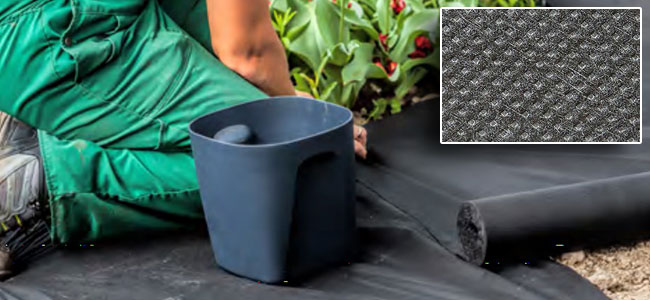
WEED BARRIER FABRIC - STANDARD GRADE
To control weed intrusion in a landscape a weed barrier is recommended as a safeguard. Our standard weed barrier / geo cloth, allows air, water and nutrients to pass through the fabric while reducing weed growth. We provide a comprehensive selection of weed barrier roll sizes to suit nearly every application.
Please note that the below levels are an approximation.
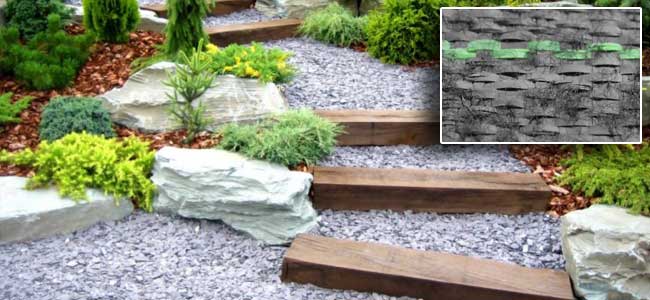
WEED BARRIER FABRIC - HEAVY DUTY
If your project requires a heavy-duty weed barrier geotextile, look no further than our hybrid selection of weed barrier geotextile fabric. Constructed of 4.1 & 4.75 oz fabric, the weed guard consists of both woven and non-woven fibers which resists tearing, allows water to pass through and provides long lasting, heavy duty weed protection.
Please note that the below levels are an approximation.
DRAINAGE & FILTRATION FABRIC:
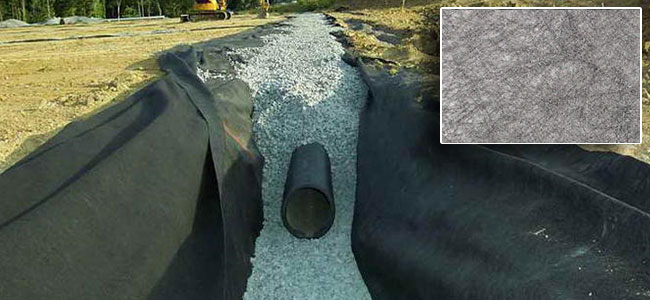
DRAINAGE & FILTRATION FABRIC -
STANDARD GRADE
Our selection of drainage & filtration fabric is ideal for use in various drainage applications including french drains and septic drain fields and also for use as an underlayment for geocell and other ground stabilization grids.
Please note that the below levels are an approximation.
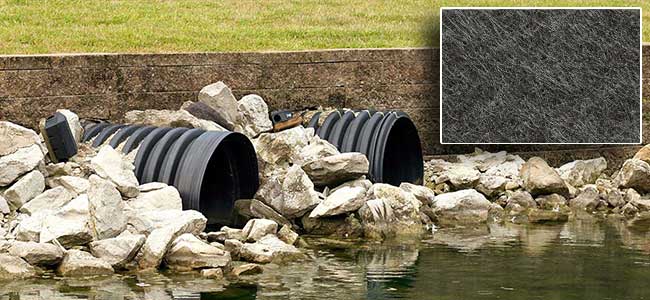
DRAINAGE & FILTRATION FABRIC -
HEAVY DUTY
When the application calls for a heavy duty fabric which is both strong and permeable, consider our selection of heavy duty drainage & filtration fabric. These fabrics are ideal for use anywhere a high strength, permeable separation layer is required.
Please note that the below levels are an approximation.
EROSION, HEAVY DRAINAGE & STABILIZATION FABRIC:
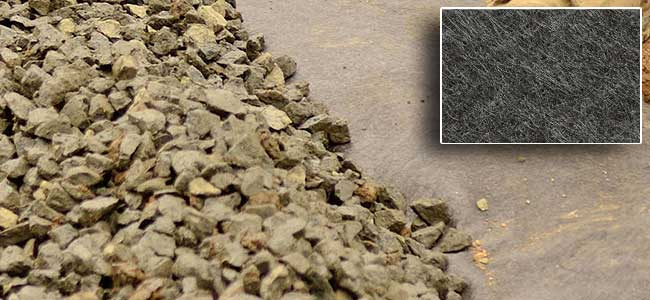
DRAINAGE & EROSION CONTROL FABRIC -
ULTRA HEAVY-DUTY GRADE
These fabrics are designed for applications with major erosion issues or in places where the highest strength permeable fabric is required. Applications include under heavy rip-rap on construction sites, behind boulder retaining walls or as an underlayment to rubber lined containment ponds.
Please note that the below levels are an approximation.
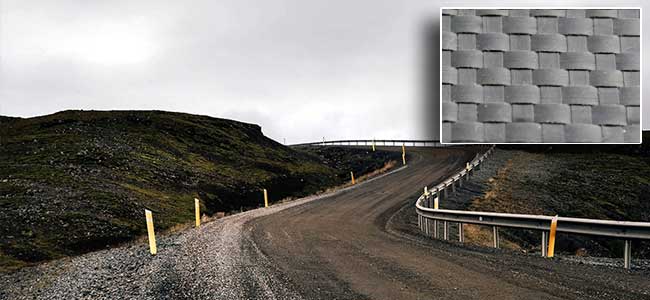
WOVEN STABILIZATION FABRIC - HEAVY DUTY
Our selection of woven stabilization fabric consists of a minimum of 200lb tensile strength and is designed to provide a stabilizing & separating layer for load bearing projects. These fabrics are puncture and tear resistant and many meet DOT specifications. Common applications include driveways, parking lots, roads and paver patios. Using a stabilization fabric reduces the amount of base materials required for the project due to it’s stabilizing properties.
Please note that the below levels are an approximation.
GROUND COVER FABRIC:
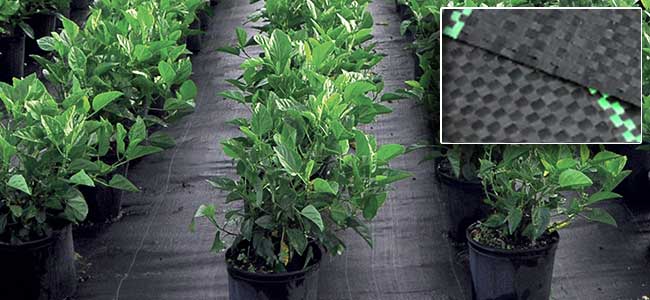
WOVEN GROUND COVER - NURSERY GRADE
Our nursery fabric selection provides high uv resistance and is available in either black or white color. This fabric acts as a weed barrier while providing sufficient strength for direct occasional foot traffic as in a nursery environment.
Please note that the below levels are an approximation.

SHORELINE EROSION CONTROL FABRIC
We provide a wide selection of shoreline erosion control fabrics for placement under riprap. Erosion control fabrics aid in providing stability and separation in shoreline applications.
Shop by Fabric Weight
Looking for a specifically weighted non-woven geotextile fabric? We offer Non-Woven fabrics ranging from 4 oz - 16 oz in a variety of different roll sizes.
Shop by Fabric WeightThe Differences Between Woven & Non-Woven Geotextiles
Geotextile Fabric (also referred to as "geotech fabric") is designed to stabilize and improve soil. They are typically made from various materials typically polyester or polypropylene.

Aerial View of Nursery Ground Cover Fabric
Woven Geotextiles -
Woven geotextiles are created by weaving narrow strips of film together to provide reinforcement and separation. The polypropylene landscape fabric is specified by tensile strength and is resistant to deformation when under pressure. These woven fabrics are plastic-like to the touch and in appearance. Due to their composition water drainage through the fabric is typically quite limited. Stabilization woven geotextiles do have the ability to handle very high loads and are typically used as an underlayment under roads or parking lots. If your project consists of a gravel walkway consider using a weed barrier under gravel to keep a clean path that is easy to maintain.
Non-Woven Geotextiles -
These fabrics are created by using needle punching not weaving. It's normally used for separation, filtration, and drainage. Non-woven fabric is referred to by weight and looks and feels like felt. They are penetrable, but not normally used for drainage or filtration applications.
Keep in mind, using the correct geotextile for your landscaping project will increase its lifespan and improve your design. It is less likely you will get callbacks caused by drainage issues or settling if you use the correct product for the correct project.
Hybrid fabrics
Our commercial grade weed barrier is a hybrid fabric made from a woven geotextile produced by needle punching polypropylene non-woven fibers into the weave to form a high strength fabric with better water permeability.
There are many people who confuse a drainage system with a drain pipe filled with gravel as a French drain. French drains are filled with gravel but there are no pipes involved. The term gravel can vary but in this article, gravel is an aggregate of small stones.
French Drains And Non-Woven Fabrics -
Non-woven fabrics are often used in French Drains. If you are not familiar with French drains, you probably don't know when they are the best choice for a project or how to install them. As an example, if you have a neighbor whose property sits up higher than yours you have probably experienced excessive water or moisture on your property. Water will easily run down from your neighbor's property and land in your yard. You will need a really good drainage system and the installation of the French drains would be an excellent choice.
There are many people who confuse a drainage system with a drain pipe filled with gravel as a French drain. French drains are filled with gravel but there are no pipes involved. The term gravel can vary but in this article, gravel is an aggregate of small stones.
Installing A French Drain -
First off, you need to find the area on your property where excessive water is accumulating from the slope and get it rerouted. Your options will dictate where the water is being rerouted. Without a doubt, if the water is traveling toward your home, it will harm your foundation so you need to find a place to reroute it as quickly as possible. The perfect place for a French drain should be an out-of-the-way place that has sandy soil and water can travel without causing harm.
Show Caution! When choosing the location to reroute the water, make sure it will not impact someone else's property. If the French drain does send water to someone else's property, you could possibly face a legal issue.
Check with your local city codes before digging and check with your utility company to know where your underground cables are located. You cannot dig where there are cables. Get the local phone number for your utility company to make sure you are digging in a safe place where no cables are buried.
The perfect solution is to run your French drain along the slope on your side of the property line. You want an area that does not have obstacles or obstructions that could lead to complications. Before you start digging, lay out the French drain area. You will have to create a small slope to carry the water to its final destination. A grade of 1% which is a drop of one foot per every 100 feet in length. Some people will suggest a drop of 6 inches for every 100 feet. It's critical to get the water to flow where you want it to in order to improve your yard's drainage and this grade will help you out.
There are many people who confuse a drainage system with a drain pipe filled with gravel as a French drain. French drains are filled with gravel but there are no pipes involved. The term gravel can vary but in this article, gravel is an aggregate of small stones.
Measuring The Grade -
Place two stakes into the ground marking the beginning and the end of the trench. Tightly tie one string to one of the stakes and then run it to the other stake and loosely tighten it. Attach a string level to the string and adjust it to get it leveled. Once that's done, tighten the string on the second stake. Make sure the string is taut. Now it's time to start digging the trench.
You can measure down from the string to ensure you are getting the required grade. Check your depth as you go along. If the trench is at the correct length, 100 feet, when grade 1% and you have reached 50 feet, your trench should be 6 inches deeper than from the point where you started.
The most difficult part of the French drain is digging the horizontal trench that runs across the length of the slope. Your trench has to slope down to the place where the water will be rerouted. If it doesn't make it to the designated spot, you will have to dig a connection ditch which will be a lot of added work. The width of the trench will depend on the level of water problems you have. The more water, you are dealing with the wider your trench will be. Smaller trenches are approximately 5 to 6 inches.

Weed Barrier Fabric Used in Garden
Before placing your gravel fill, make sure your trench lines up with the fabric. The non-woven fabric will keep dirt out of the gravel. Your gravel must be protected so it can filter water through it. It's critical that the French drain operates correctly. Add coarse gravel onto the fabric, and fold the fabric ends over the gravel.
When you are done, you will have a tube of fabric filled with gravel. To fill in the rest of the trench, place a layer of coarse sand then cover it with landscaping fabric. Add 4 inches of topsoil and place sod on top of that. You will have a completed French drain.
Help For Beginners -
If you are having problems getting the proper grading, you should consult with a contractor or someone who is familiar with French drains including the entire project. If digging the trench is difficult to do, you can hire a backhoe operator. It will add to your expenses along with the extra gravel because the backhoe cannot dig a small trench as you can do manually. Another alternative, hire a trencher that can cut very thin trenches.
If you can use a small trench for your drain, you will save a good deal of money and need a lot less gravel. The most difficult part involved in a French drain is figuring out where to run the water. If at all possible, one of the best avenues is running the water out to the road where the city's drain will take care of it. All said you should do some research to find out what would be a good choice and what would not.
Tools & Items You Need To Install a French Drain
- Drainage Fabric
- Gravel
- Sand
- Sod
- A Spade or Shovel
- String level string
- Two Stakes
- A Tape Measurement
Another alternative for placing your drain could be a dry creek.
Every gardener and landscaper's ideal yard is well-maintained and beautiful to look at. Weeds popping up and a lack of good drainage is quite common but can be taken care of by using landscape fabric. Your biggest concern might be which project needs woven fabric and which needs non-woven fabric.
First off, both woven and non-woven have different strengths and weaknesses.
Woven landscaping fabric is strong as well as long-lasting, it's great for weed control, and supporting driveways and walkways.
Non-woven fabric is weaker but allows for good water drainage but not that good for weed control.
While these are only two kinds of landscape fabric, each offers many uses. These fabrics will keep soil in place and protect landscapes from intermittent weather Each fabric offers benefits for keeping your landscape looking like new and in great shape. We will delve more into the details as well as how to choose the right fabric and how to install it correctly.

Installing Geotextile Fabric at Jobsite
Does It Matter Whether You Use Woven or Non-Woven Fabric?
Whether you are a consummate landscaper or have simply admired various landscapes you have seen, you might be familiar with this fabric.
Landscape fabric can also be used for other places such as:
Playgrounds
Commercial landscapes and properties
Many other locations where landscaping and property management are taking place.
I'm sure landscaping fabric is everywhere but knowing what it is and how to use the fabrics is something totally different. In order to understand how to use landscape fabric the right way, you have to understand what the different types are and when they should be used.
Lawn and Garden Fabrics
One of the most common problems for lawns and gardens would be weeds. Shards of grass will pop up through cracks in your driveway and take over garden beds causing a lot of destruction. Adding to the problem, not treating weeds properly can cause issues even if you have stocked up on herbicides. Choosing the wrong kind of fabric would mean the difference between proper weed control or no weed control at all. The two main kinds of landscape fabric are woven and non-woven. Each offers its own benefits when used on different kinds of landscapes.
Woven and non-woven fabrics offer different materials for different uses, and benefits, and have some disadvantages. The kind of fabric you use will depend on several factors:
- Where do you want to install it
- The kind of earth you will place on top of it
- Your climate
- The reason for the installation
One of the biggest differences between the two fabrics is the material of which they are constructed. Woven fabric is typically made of polypropylene. The material is woven together creating a crisscross pattern that is very strong and long-lasting. Woven landscape fabric is great for heavy-duty stabilization projects.
Non-woven landscape fabric is made from polypropylene that has been bonded together. Once bonded together using thermal heat, the holes are needle-punched through the material making it absorbent. This also makes non-woven landscape fabric easier to cut.
As mentioned earlier, woven landscape fabric consists of polypropylene that is woven together creating a very strong impenetrable layer of fabric. The unique pattern will make the material strong so it will hold its shape and offer a solid membrane. In most cases, this fabric is used for roads and paths due to its well-known strength.
Some of the best applications using woven fabric include:
Woven fabric is extremely durable and well-suited for landscapes that need stability. For applications when paving material is being laid down, woven fabric can stop the pavement from sinking into the soil.
For projects that need strength and durability, woven landscape fabric is less likely to wear down over time in comparison to non-woven. Its strong material is ideal for stability in certain landscapes.
Landscapes on a budget need woven fabric as it's less expensive than non-woven fabrics. Also, due to its great durability over time, you will not have to replace it as often, which will help save on cost.
Note: A commonly requested application for landscape fabric is for utilization as a protection layer underneath grass to repel gophers. Landscape fabric is not ideal for this application as it will prevent grass roots from establishing and does not provide the strength required to repel gophers. Consider utilizing specialized gopher wire for this specific application.
Regarding Non-Woven Fabric
Non-woven landscape fabric offers more benefits compared to woven fabric. This fabric does provide a moderate level of durability. Even though it's not as strong as woven fabric, its manufacturing process increases its water absorbency. This is a crucial benefit for good drainage and preventing waterlogging from taking place.
Added Support For Soil Drainage -
Non-woven landscape fabric is ideal for supporting good soil drainage. Having good drainage is very important when it comes to landscaping. It will ensure the soil gets adequate moisture without the area becoming waterlogged.
Under Patios, Driveways, and Roads -
Non-woven landscape fabric works very well under patios, driveways, and roads which is very similar to woven fabric. It's also a great choice for various heavy-duty projects.
Frost Blanket
The Frost Blanket for Plants helps lengthen the harvest time and flowering season by keeping the air warmer underneath it than above it. This fabric is available in various roll sizes.

Ground Cover Fabric At Nursery
Blocking Weeds From Growing Out-Of-Control -
One of the leading common uses for landscape liner fabric also called weed stop fabric, is controlling weeds. When you prevent the sun from reaching the weeds, non-woven fabric will help control their growth.
Note: If you want to prevent any growth we also offer our plastic weed barrier. It will not let any sunlight, water, or air through to reach the soil below so there will be no plant life.
The 5 General Uses for Landscape / Geotextile Fabric:
- Separation
- Stabilization
- Reinforcement
- Filtration
- Drainage
- Weed Control
Each of these uses is typically accomplished by a specific fabric with caters to that specific use. In most situations however, the application is calling for not just one but two or there of these uses to be accomplished by a single fabric. In this situation the buyer needs to find a fabric which accomplishes the required uses to a satisfactory level.
For Separation
There are many sides to landscaping. You need to know what areas certain plants work well in and how to place the landscaping fabric correctly. Also, the connection between soil, mesh, and what soils will work together can vary. The bottom line, not all soils mix well together or equally.
The consistency of certain soils when mixed together can lead to inconsistencies when talking about the ground you walk on. If incompatible soils mix together, it can cause the ground to become uneven. In situations like that, landscape fabric is a necessity and you might wonder why. Landscape fabric will help to keep soils of different inconsistencies separate by working like a barrier between these soils. This in turn will prevent the soils from mixing and causing the ground to sink.
Tip: We have many different products to support your project, whether it’s a tortoise fence or dump box liner we can help.

Geotextile Fabric used as a Separator
Stabilization
Another great benefit of using landscape fabric is for stabilization. Ground stabilization and soil separation will work hand-in-hand in some cases. Landscape fabric will keep the soils of different inconsistencies separate and help to keep them stabilized.
For certain areas that have slopes, landscaping fabric is very important. These areas could experience erosion so having erosion control fabric to stabilize the slope is crucial. Not only will it keep the layers of soil separated, but it can keep them stabilized.
The best choice for stabilization is woven landscape fabric (also referred to as driveway fabric). It will keep the soil in place as well as keep the material on top from moving around. It's durable and there are some brands specifically created for this reason. Woven fabric is also used for heavy-duty placement including:
- Under Patios
- Driveways
- Roads
Reinforcement
Compared to the other uses for landscape fabric, reinforcement is the most important. It can shape or form so when reinforcement is required in all aspects of landscaping, this fabric will make it possible.
In some cases where an area has become damaged, the soil will become depleted of nutrients. Using fabric as a reinforcer will allow the area to recover. When placed on areas that need some TLC, landscape fabric will prevent the area from exposure to sun and an invasion by weeds.
Also, if you discover your garden beds have become totally depleted, using fabric can give the soil time to recuperate and rebuild its nutrient levels.
Filtration
Filtration is very important for keeping landscape in good shape. Filtration allows soil particles to filter through without becoming clogged up. Non-woven landscape fabric is great for filtration and drainage. Non-woven fabric is permeable, or absorbent, so water is able to pass through. When using a permeable landscape fabric, you can be sure the water and soil will drain and filter properly.
Pro Tip: When the weather changes consider our row cover fabric to raise the temperature of the plants while still allowing air to flow.
Drainage
No one wants to come home to a swampy yard or garden bed but that will happen if drainage is really poor causing the area to become waterlogged.
Good drainage is critical for maintaining any form of plant life whether it's the grass, a garden, or a flower bed. Also, drainage is important when dealing with blacktop areas, beneath patios, and areas with gravel.
If you use woven fabric instead of non-woven fabric where you need good drainage, you are running the risk of having many problems down the road.
Poor Drainage Can Cause:
- Soil Erosion
- Instability of driveways and structures on top.
- Overwatering plants will kill them without proper drainage
- Gross Smelling “Bog” conditions in the soil.

Nursery Ground Cover Fabric Installation
How To Find The Right Fabric
As mentioned throughout the article, there are two main kinds of landscape fabric, woven and non-woven. These fabrics come in a variety of styles and brands. They also come with their own price tags. When looking to find the landscape fabric that's right for you, there are some things to consider.
- The price
- The quality of the materials
- The fabric material itself
Know What To Look For When Choosing The Fabric
There are many qualities in good landscape fabric as well as the fabric that will be best suited for your project. Because there are different landscaping fabrics to choose from, it's really important to be very specific about what you are looking for and what you need the fabric for.

Hole Cut in Fabric for Plant
How To Use The Landscape Fabric
Knowing how to use landscape fabric properly is very important for getting the results you are looking for. When placing the landscape fabric the right way, you will discover its excellent benefits. If this fabric is not placed the right way, there will be issues down the road because it will not perform as it should. Using the landscape fabric the wrong way will eventually lead to several disadvantages.
No Landscape Fabric Is Completely Weed-Proof
There are no guarantees that putting down landscape fabric will prevent weeds from surfacing but putting down the fabric will prevent the majority of weeds from popping up. Just placing down landscape fabric will not guarantee all weeds will disappear.
Tip: If you want to grow plants without mulch consider white landscape fabric. It is UV stabilized to last longer in the sun and has planting stripes to help organize your plantings.
Even though this fabric is not 100% weed-proof, using the landscape fabric the right way will help control and maintain other things you should know about. As an example, in areas that have slopes, using landscape fabric will aid in controlling the rate of erosion. and can help to prevent landslides.
The Benefits Of Using Non-Woven Landscape Fabric
Using this fabric for your next project can have many benefits. While it is more expensive and requires more work, it should not prevent you from using it due to its excellent benefits.
Some Benefits
- This fabric helps to retain moisture.
- Offers better weed control.
- Will help to maintain the state of the targeted landscape or terrain.
- It will eliminate the use of chemicals to control weeds.
- Reduces erosion and works as a stabilizer.
Although it will not guarantee to eliminate all weeds, it does a very good job across the board. Also, you will not have to rely on harmful chemicals that most of us do not want to deal with. With that in mind, there is a big difference between dealing with a handful of weeds or a yard full of weeds.
Once you understand how to use landscape fabric, it's time to move on to the actual installation. This step does not require a lot of work outside of measuring and using some planning. In order for this fabric to do what it's intended to do, it must be installed properly. Performing the right installation will give you many of the benefits you are looking for.
Depending on the reason for using the fabric, the installation may be somewhat different. For instance, if you plan to use it for stabilizing the ground and for soil separation, there could be more steps involved during installation. The following steps for proper installation will give you a good overview, regardless of the reasons for using it.
Before you start the installation, make sure you have all the basic materials you will need. For a basic installation, you will need the following:
- A measuring tape
- The landscape fabric you have chosen
- Pins, ground staples, or stakes to keep the fabric in place.
- The material you will need to cover the fabric such as gravel, mulch, or soil.
Start By Measuring The Area
Take the measuring tape to measure the area you want to place the landscaping fabric on. This will give you a good idea of how much landscaping fabric you will need for the project. Also, this will give you a good idea of how much coverage you will need such as gravel, pins, and other materials.
Cut And Place The Fabric
After you have the right measurements, place the fabric over the desired area. Be sure not to cut the fabric based on your measurements before placing it down.
You can easily cut the landscape fabric using a pair of scissors or a razor knife. Do not cut the fabric until you have placed it over the area first, then cut it.
Before placing the fabric down, remember that the fuzzy side of the fabric must be face down. This will allow the fabric to become secured to the soil underneath it. This is especially important if you are placing the fabric on a slope.
If it helps, you can place sections to cover the area allowing approximately 6 inches for the edges of each section to overlap. Once you have done this, allow approximately 2 inches of excess fabric to remain. You will cover this soil later on during the installation.
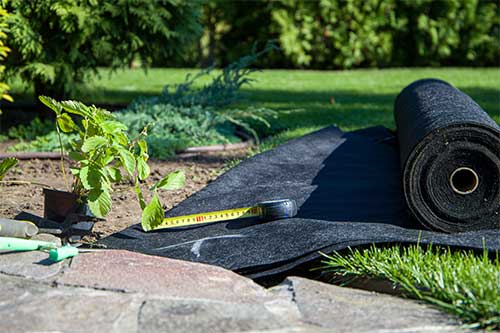
Roll of Non-Woven Fabric in Backyard
Time To Secure The Fabric
After you have placed and cut the fabric, secure it in place using pins around the area that will be in contact with the soil. You should place the pins every couple of feet.
Select The Areas For Plants
If you want plants in the selected area, be sure to mark where you want them to be. You can easily do this by marking the space with an “X” and folding back the excess fabric to reoccupy the open space for the plant.
By doing this, you can create a space for the plant and protect it from mulch or other landscaping materials you will use to cover the fabric.
Note: In the winter you can use our frost protection blanket to help protect your plants from colder temperatures. The frost protection blanket raises the temperature under the blanket while still allowing air to flow through.
In this part of the installation, it's important not to leave too much or too little space for your plants. If you know what kind of plant you want to place there, make an exact measurement of the space before cutting back the fabric. If there is too much open space for the plant, it can make it very easy for weeds to take root and grow.
Placing Landscape Material
Finally, place the landscaping material you want to use onto the landscaping fabric. Whether it's mulch, gravel, rocks, etc, the same steps apply. The final layer of the material should be approximately 2 to 3 inches thick.
Woven Or Non-Woven Landscaping Fabric
Just remember the differences between these fabrics -
Woven Fabric
This is a very strong and durable geotextile road fabric fabric that is perfect for paths and road construction, weed control, and stabilization. With that in mind, it does not allow for as much drainage.
Non-Woven Fabric
This fabric is somewhat strong, but also allows for good drainage of water. It is perfect for filtration and drainage purposes. However, it is not as effective for weed control.
In Conclusion
Woven and Non-Woven Landscaping Fabric or often called Geotextiles both have excellent properties and purposes for many different projects you have in mind for your yard, gardens, or other landscaping needs. Woven Landscaping Fabrics will provide excellent separation and reinforcement. While Non-Woven Landscaping Fabric offers separation, filtration, and drainage, it's referenced by ounce per square yard weight, is penetrable, and offers a feeling of felt when touched. Non-Woven is also the chosen fabric for French Drains.





